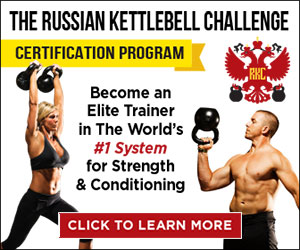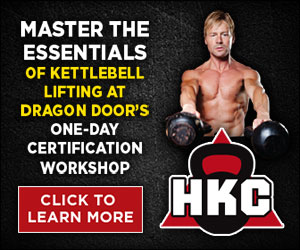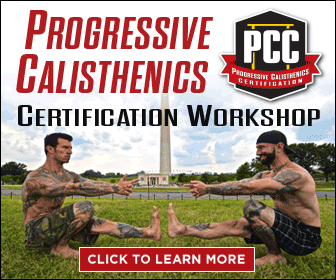For reasons no one can remember, the recent Orlando HKC was scheduled on a Sunday. Tim Shuman, Franz Snideman, Laurel Blackburn, Ryan Blackburn, myself, and of course Chris Davis (the official host) all arrived early to make sure we were all set up and ready to go. Tim’s truck was riding heavy with kettlebells
(thankfully he has a custom box for such things). After getting a fairly early start, we accidentally took the longer route among the nearly identical groupings of warehouse buildings before seeing Chris waving. We unloaded all the kettlebells
and put them safely out of the way and towards the back of the gym – I was proud to see my “tough love heart” marked Dragon Door
kettlebells
among those to be used for the workshop. [My 48kg
“Beast
” kettlebell at home looks especially amusing with it’s little red heart marking] As participants arrived, we handed them their manuals (I’d never seen an HKC manual before this time) and the usual stack of paperwork, liability forms etc. I suddenly had even MORE respect for Nicole Du Cane’s organizational skills as she makes this potentially chaotic process look so effortless with waaaay more people involved at all the RKC
, RKCII
, CK-FMS
etc. workshops
. After everyone arrived with paperwork completed, we all went into the main room and made our introductions. I am always fascinated by these first meetings, because it’s interesting to watch how people grow, develop and change over the course of a workshop. Even though an HKC workshop
is a single day, the next 8 hrs or so we would all spend together would be transformative and crammed full of information. It was cool to see that people of all ages, fitness levels, confidence levels, and backgrounds were present. There were more men than women present, but the ladies managed to represent just fine, thank you.
Since I had trained to go straight to the RKC back in October 2010, this would also be my first direct experience with an HKC workshop – so I was just as excited as the participants. I also hadn’t had the opportunity to officially help out at an event yet, so I was there, in my regulation khaki pants and RKC Instructor shirt – ready to help! [These are the first khaki pants I have owned in over a decade—this is a big deal for someone who wears only black, dark grey, or tiny bits of red. They look a LOT like the ones you see Pavel (his are Patagonia brand – which are insanely cool and durable) wearing in many photos and DVDs. Mine are from a brand called ExOfficio and are ridiculously comfortable.] After we all went around the circle for introductions, it was time for the initial strength testing—even though no one really knew each other—the atmosphere was very supportive as each person completed their strength test. That’s something I really love about the community surrounding the HKC , RKC, and Dragon Door : the strong sense of community and support. The strength requirements were: Men: 5 dead hang pull ups or chin ups, Women: 15 second flex arm hang OR opt to do the pullups/chinups instead. More on pull ups later, but it’s no secret that this is literally one of my favorite exercises ever. By the way, have you seen Al Kavadlo’s new book??!!

A lot of people on the internet regularly ask me what’s the difference between HKC, Hardstyle, RKC , etc. The basic answer is that the HKC is the “entry level” kettlebell certification workshop from Dragon Door . You learn the kettlebell swing, the get up and the goblet squat – which are extremely powerful exercises. Ask my small group and you’ll soon find out exactly how much can be done with those three movements. The HKC is attended by fitness professionals as well as “regular people” who see it is a great goal and a great skill to develop for their own lifelong health. One of my clients was eventually inspired to attend an HKC. After she moved to California, she attended an HKC workshop, became certified and has been training clients of her own now! I couldn’t be more proud! The RKC Workshop lasts for 3 intense days and covers the basic “RKC 6” exercises: swing, clean, press, squat, snatch, and get up . But we all train “Hardstyle” which is defined towards the very beginning of the HKC manual as: “The reverse engineered body language of the most powerful people in the world”* The word or phrase hard style (outside of techno music circles at least) is often found in martial arts – refering to fast, powerful movements that utilize a good deal of controlled body tension, or hard style vs soft style, referencing external vs internal martial arts practices.
Every good lesson begins with the rules – kettlebell safety is always massively important – because these are such powerful and dynamic exercises, there are risks involved if we don’t know how to be safe. Like all exercise modalities, always check with your doctors first – but especially with kettlebell training as it is especially intense. Always be aware of your surroundings, wear the right (or no) shoes, practice common sense, keep moving when you take a break, stop before your form deteriorates, don’t slump! Always always always use good judgement and err on the side of caution. That’s just the tip of the iceberg, so I would encourage you to get out your favorite kettlebell book or manual and review that section in the beginning. Go ahead and give it a good read right now. This is good information and we should all remind ourselves of it regularly!
Next, Franz Snideman led us through a joint mobility complex. It was a little different from the one I had been practicing for my own workouts and for the small group. It’s more involved in some areas and less in others. I really liked the warmup as presented to the HKCs – it’s a nice standardized, step by step process that can be used by people in a variety of fitness situations as well. And really, any excuse to do the prying cobra move is totally ok by me.


If there’s one thing that you should learn from kettlebell swings, it’s how to use your hips. Shakira jokes aside, I like to say that the hips comprise the biggest hinge in the body. When you can coordinate that movement within the kettlebell swing, the amount of power you can generate by using your whole body is simply amazing. You WILL surprise yourself. Learning to generate and control and release the full body tension necessary for the swing will also make sure that the swing really IS a full body exercise. And trust me on this, I’ve been able to FINALLY get the fitness results I’ve wanted because of the kettlebell swing. Results which previously had eluded me through trying nearly everything. Not even going to list everything I’ve tried over the years because frankly, it’s embarrassing! Kettlebell swings… they get the job done quickly and you can even keep your dignity!

Bonus Box!
*I also recently read the ever so interesting book In The Devil’s Garden: A Sinful History of Forbidden Food the amusing quote from the author Stewart Lee Allen: “Eating well is, of course, the ultimate expression of power…” So I’m feeling pretty powerful over here right about now…..







Leave a Reply